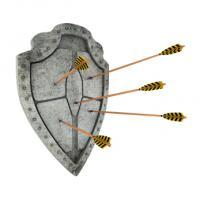
Keep it Together
For the past few weeks we were busy exploring opposite-colored bishop endgames with other material present on the board. Today I will deviate from the topic by showing you my recent endgame experience from a tournament in Las Vegas. I cannot call my endgame technique a success story but it is improving. The endgame that we will look at today resulted from a losing middlegame position, so I was lucky enough to survive until the endgame.
Do not ask me how I got myself into this troublesome position – I played the opening pretty badly. The opening stage can be summed up as me being under serious attack with many pawn weaknesses. Given the pawn weaknesses on h5 and a4 and probably on c6 and b6 the endgame cannot be good for black. As bad as endgames can be, when one is under deadly attack the endgame becomes one of your few hopes.
Black does not have a clear plan in this position, maybe playing Kh8, Rg6 and doubling with the rooks on the g-file to attack the weakness on g2. White can slowly improve his position by bringing the other rook from a1 and bringing the king away from the g1 square, where it can come under check. Instead, white went for a direct assault, which put me in a worse endgame, which I was praying to get.
With the last move h4 white not only cut the knight on h7 from the play but also threatens to take the d4 pawn after Rf4. Right away Rf4 does not work because of the Ng5-Nf3 threat. What should black do? During the game there were two plans that appealed to me. One plan was to attack white's weak pawns with the rooks, while the other plan was to develop the knight. Attacking the pawns can be achieved with Rg4 or Rd5, while knight activation can be either through e6 or through Ke8. Which would you prefer?
We have arrived at a critical position for white. If white does not take the pawn on d4 then after Ne6, black‘s position would be better. There are two moves: N:d4 and R:d4 and only one of them leads to advantage. Trading rooks would be good for white because their king is not so well defended and there is a possibility for attack. On the other hand taking the pawn with the knight leads more or less forcedly into the four-rook endgame where the white rooks are active and can target the weak black pawns? Which one to choose?
When you are defending the whole game it is hard to stop defending and realize that there is a chance for an advantage. Since the opening, black could not dream of more than a draw. With tenacious defense and the opponent’s help black equalized. Now, Re1 was not the best move and it is up to black to figure out where there are more chances: in the rook endgame or in the endgame where both rooks and knights are present. During the game I did not evaluate the resulting positions correctly and a draw was agreed four moves later.
The opponent offered me a draw although we could have played the position out. This was the last round of the tournament and tiredness set in. The position is objectively equal. Even if one or the other side loses a pawn somewhere the game would probably remain equal as it is hard to realize an extra pawn in rook endgames. The game can fall under the category of defending, defending, and again defending. I observed an interesting idea that I will share with you in the next article. If the position is bad (as the initial position is here) and you want to give up the fight because every resulting position looks so bad, tell yourself: “I will make one move that does not lose immediately”. It is an excellent start and you would be surprised at the results this idea produces.






